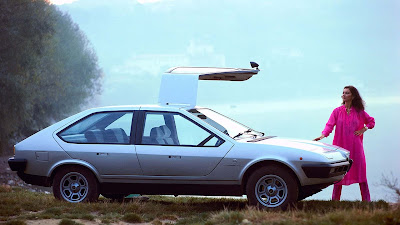BOLD Concept - In the realm of automotive innovation, Ford Motor Company has left an indelible mark with its ventures into concept vehicles. During the 1990s, in collaboration with third-party entities, Ford had done many journey of design exploration, laying the groundwork for future production models. Among these notable collaborations was the partnership with Italian Coachbuilder Carrozzeria Ghia, resulting in groundbreaking creations like the Ford Focus Concept discussed previously.
 |
| This 1996 Ford Ghia Vivace is a one-off concept car developed by Ford in alliance with Ghia as an exercise in experimenting with aluminum space frame design techniques. (Picture from: BringATrailer) |
Now, turning the pages of automotive history to 1996, we encounter another gem from the Ford-Ghia alliance: the Ford Ghia Vivace Concept. This visionary creation, part of a duo alongside the Ghia Arioso Concept, delved into the realm of aluminum space frame construction techniques, showcasing Ford's relentless pursuit of innovative designs aligned with evolving materials and construction methodologies.
 |
| The 1996 Ford Ghia Vivace was built on the Ford Mondeo platform, featuring a projected 24-valve 2.5-liter V-6 engine, embodying dynamism and assertiveness. (Picture from: BringATrailer) |
At the core of automotive excellence lies not just cutting-edge engineering but also the fusion of functionality with aesthetic allure. The Ghia Vivace Concept epitomizes this fusion—a 2+2 coupe exuding emotive charm through its rounded, tightly-wrapped contours and high-haunched profile. Built upon the Ford Mondeo platform and powered by a 24-valve 2.5-liter V-6 engine, this concept embodies dynamism and assertiveness.
 |
| The 1996 Ford Ghia Vivace features a sleek exterior design with concave rocker panels, a distinctive stroke along its flanks, and a rapid curvature leading to a rounded tail and decklid adorned with modern oval taillights. (Picture from: BringATrailer) |
The exterior design of the Ghia Vivace Concept is a symphony of curves and concavities, accentuated by concave rocker panels and a distinctive stroke along its flanks originating from the front bumper corners. The rear showcases a rapid curvature leading to a rounded tail and decklid reminiscent of classic coupes, adorned with modern oval taillights perched high at the corners.
 |
| The 1996 Ford Ghia Vivace, with its two-door coupe design, showcases a 2+2 interior layout featuring a brown fabric deck, a partial steering wheel, and seat backs (none of which are functional as the doors do not open). (Picture from: BringATrailer) |
It's important to note that the Ghia Vivace Concept, while a visual marvel, is primarily a platform concept without an interior, steering, or operable doors/windows. Constructed in fiberglass with plastic wheel covers, its surface finish reveals the fiberglass weave, adding a raw, industrial charm. This one-off rolling model, lacking an engine and transmission, sits atop a boxed steel frame, exemplifying the marriage of engineering prowess and artistic vision.
 |
| The 1996 Ford Ghia Vivace, a one-off rolling model, lacks an engine and transmission, resting atop a boxed steel frame that exemplifies the blend of engineering prowess and artistic vision. (Picture from: BringATrailer) |
As with many rare automotive treasures, the Ghia Vivace Concept found its way into the hands of discerning collectors, eventually gracing the halls of the Sarasota Classic Car Museum in Florida. Its journey, from concept genesis to collector's gem, underscores the timeless allure of automotive artistry and the quest for design excellence. | 5o7Pb3cSF4E |
 As quoted from BringATrailer, this concept car sold for $3,050 at an auction held on October 28, 2020. In the tapestry of automotive history, the Ghia Vivace Concept stands as a testament to Ford's pioneering spirit and the collaborative ingenuity that continues to drive innovation in the ever-evolving world of automobiles. *** [EKA | FROM VARIOUS SOURCES | BRINGATRAILER | MYSTERIOUS ADHD ]
As quoted from BringATrailer, this concept car sold for $3,050 at an auction held on October 28, 2020. In the tapestry of automotive history, the Ghia Vivace Concept stands as a testament to Ford's pioneering spirit and the collaborative ingenuity that continues to drive innovation in the ever-evolving world of automobiles. *** [EKA | FROM VARIOUS SOURCES | BRINGATRAILER | MYSTERIOUS ADHD ]Note: This blog can be accessed via your smart phone.













































